Related Research Articles

The Nintendo 64 (N64) is a home video game console developed by Nintendo. The successor to the Super Nintendo Entertainment System, it was released on June 23, 1996, in Japan, on September 29, 1996, in North America, and March 1, 1997, in Europe and Australia. It was the last major home console to use cartridges as its primary storage format until the Nintendo Switch in 2017. It competed primarily with the Sony PlayStation, the Sega Saturn, and the Sony PlayStation 2.
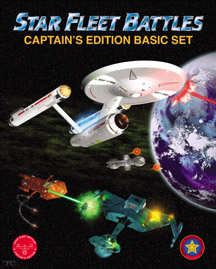
Star Fleet Battles (SFB) is a tactical board wargame set in an offshoot of the Star Trek setting called the Star Fleet Universe. Originally created in 1979 by Stephen V. Cole, it has had four major editions. The current edition is published by Amarillo Design Bureau as Star Fleet Battles, Captain's Edition.

Battlefleet Gothic is a miniature wargame that was produced by Games Workshop from 1999 to 2013. It simulates combat between large spaceships. It was developed primarily by Andy Chambers. Although this miniature wargame is no longer supported by Games Workshop, a number of video game adaptations have been made since its cancellation.

Cosmic Encounter is a science fiction–themed strategy board game designed by "Future Pastimes" and originally published by Eon Games in 1977. In it, each player takes the role of a particular alien species, each with a unique power to bend or break one of the rules of the game, trying to establish control over the universe. The game was inducted into the Academy of Adventure Gaming Arts & Design Adventure Gaming Hall of Fame in 1997.
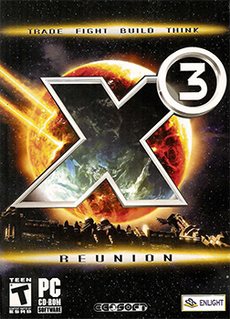
X3: Reunion is a single-player space trading and combat video game developed by Egosoft and published by Deep Silver. It is the third installment in the X series and the sequel to X2: The Threat (2003), which in turn followed X: Beyond the Frontier (1999). X3: Reunion was released originally for Windows in 2005. The game was later ported to Mac OS X and Linux.

Master of Orion II: Battle at Antares is a 4X turn-based strategy game set in space, designed by Steve Barcia and Ken Burd, and developed by Simtex, who developed its predecessor Master of Orion and Master of Magic. The PC version was published by MicroProse in 1996, and the Macintosh version a year later by MacSoft, in partnership with MicroProse. The game has retained a large fan base, and is still played online.

Axis & Allies is a real-time strategy World War II video game developed by TimeGate Studios and published by Atari for Microsoft Windows. The game was released on November 2, 2004. It is based on the board game series Axis & Allies from Milton Bradley and also on TimeGate's Kohan series. Set in the years after Japan and the United States entered into the war, the game allows the player to act as a World War II commander to build military forces to fight against other generals, using military units and technologies from the war. The player is able to rewrite and recreate the history of World War II.
Starfire is a board wargame simulating space warfare and empire building in the 23rd century, created by Stephen V. Cole in 1979.

Dune is a strategy board game set in Frank Herbert's Dune universe, published by Avalon Hill in 1979. The game was designed by Bill Eberle, Jack Kittredge and Peter Olotka. After many years out of print, the game was reissued by Gale Force Nine in 2019 in advance of the 2021 Dune film adaptation.
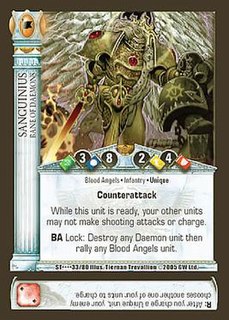
Horus Heresy is an out-of-print collectible card game originally produced in 2003 by Sabertooth Games. The game is set in the Warhammer 40,000 fictional universe developed by parent company Games Workshop. It attempts to recreate the struggle between the Loyalist forces of the Emperor of Mankind and the Traitor forces of Warmaster Horus, during the civil war known as the Horus Heresy. The game's development and sale by the publisher were discontinued in 2008, following financial difficulties at the parent company.

Twilight Imperium is a strategy board game produced by Fantasy Flight Games in the genre of science fiction and space opera. It was designed by Christian T. Petersen and was first released in 1997. The game is in its fourth edition (2017), which has large changes over previous editions. It is known for the length of its gameplay, and its in-depth strategy.
StarCraft: The Board Game, published by Fantasy Flight Games, is a game inspired by the 1998 computer game StarCraft. Players take control of the three distinctive races featured in the video games, the Terrans, the Protoss, or the Zerg, to engage in battle across multiple worlds in order to achieve victory. Each of the three races features a fairly different playing style. A prototype of the game was shown in BlizzCon 2007, with pre-release copies sold at Gen Con 2007 and Penny Arcade Expo 2007. It was publicly released in October 2007.
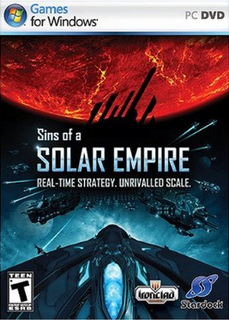
Sins of a Solar Empire is a 2008 science fiction real-time strategy video game developed by Ironclad Games and published by Stardock Entertainment for Microsoft Windows operating systems. It is a real-time strategy (RTS) game that incorporates some elements from 4X games; its makers describe it as "RT4X". Players are given control of a spacefaring empire in the distant future, and are tasked with conquering star systems using military, economic and diplomatic means.

Starship Catan is a two-player card game, loosely based on the Starfarers of Catan board game. As a member of the Catan family of games, it is designed by Klaus Teuber, and distributed by Kosmos in German and Mayfair Games in English.
Planetarion is a browser-based massively multiplayer online game. Created by Fifth Season AS in early 2000, then bought by Jolt in 2003, and then purchased by Renegade Games in 2009; it is now currently owned by Jagex. The game places players in control of a planet, with the ability to mine its asteroids for resources, enabling them to construct a fleet of spaceships to attack other players' planets. Although its popularity has declined with the emergence of other similar games and the introduction of a pay-to-play model, which has since been changed to a freemium format, the game is currently still active, and as such is one of the oldest running internet games of its genre.
UltraPin is a Multi-Game pinball arcade game that holds 12 digital recreations of Williams Electronics real pinball games in a single pinball cabinet. UltraPin is built in a traditional style pinball cabinet to look and feel like a real pinball machine. It has two LCD screens, a 19 inch LCD for the back glass and DMD, and a 32 inch LCD for the playfield, and it uses Windows XP Embedded for its operating system.

Warhammer 40,000: Dawn of War – Dark Crusade is the second expansion to the real-time strategy video game Warhammer 40,000: Dawn of War developed by Relic Entertainment and published by THQ. Based on Games Workshop's tabletop wargame, Warhammer 40,000, Dark Crusade was released on October 9, 2006. The expansion features two new races, the Tau Empire and the Necrons. Including the Imperial Guard from Dawn of War's first expansion pack Winter Assault, a total of seven playable races in this expansion.
Sid Meier's Civilization: The Boardgame is a 2002 board game created by Glenn Drover based on the Civilization series of video games, in particular, Civilization III. Drover himself was a sales manager at Microprose during the original development of Civilization, though he was not directly involved in the creation of the video game.

Zero-K is a free multi-platform open source real-time strategy video game. Initially based on content from Total Annihilation on the open source Spring Engine, it was forked and all proprietary content replaced, and evolved into a completely new game with unique features. Among the games powered by the Spring Engine, Zero-K makes extensive use of Lua scripting for interface and gameplay changes/enhancements, as well as unique real-time strategy concepts such as a flat technology tree.
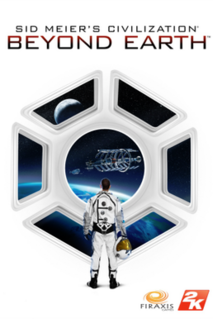
Sid Meier's Civilization: Beyond Earth is a turn-based strategy, 4X video game in the Civilization series developed by Firaxis Games, published by 2K Games and released for Microsoft Windows on October 24, 2014, the Mac App Store on November 27, 2014 and for Linux on December 18, 2014. A spiritual successor to Alpha Centauri, Beyond Earth shares much of that game's development team, as well as some concepts which were introduced in the 1999 title. The game's setting is unique to the Civilization series in that it takes place in the future, with mankind traveling through space and founding colonies on extraterrestrial planets after Earth becomes uninhabitable due to an undescribed disaster known as "the Great Mistake".
References
- ↑ UltraCorps, About UltraCorps. Steve Jackson Games.
- ↑ Board Game Geek, UltraCorps - The Boardgame That Isn't, by Oliver Kiley, 14 May 2012
- ↑ Gamespot, UltraCorps Review, by Michael E; 3 November 1998.